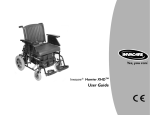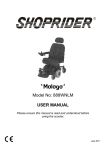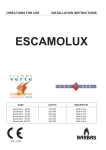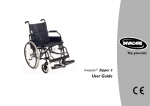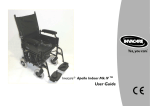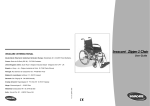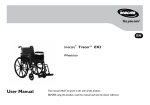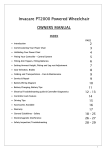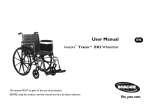Download 7 Adjustment 7.1 Seat Depth & Backrest Angle
Transcript
7 7.1 Adjustment Seat Depth & Backrest Angle Adjustment (Manual) ADJUSTING: The backrest has 3.5cm of depth adjustment and 12° of tilt adjustment (where applicable). The individual fitting of the firm backrest allows the seat depth to be adjusted by 3.5cm. The backrest angle can be adjusted from the vertical through to 12°. SEAT DEPTH ADJUSTMENT: 1. Unscrew and remove the four bolts (A) and nuts from the backrest mounting brackets. 2. Move the backrest into the desired position. 3. Replace the four bolts and nuts into the mounting bracket and frame and firmly fasten. B C BACKREST ANGLE ADJUSTMENT: 1. Release the lock nut (B) located on the crossheaded screw. 2. Screw the locking screw (C) partially out under thumb pressure. 3. Screw the cross headed screw in or out to give the desired back angle position. 4. Adjust the position of locking screw knob as necessary. 5. Position the lock nut up to the hinge bracket and fully tighten. 6. Re-tighten locking screw knob (C) fully, ensure backrest assembly is secure. 31 A NOTE: Each backrest post must be positioned in the same plane as the other or the backrest will be twisted. To enable the chair to be more portable, the backrest can be either folded down or detached from the wheelchair base. TO FOLD THE BACKREST: B 1. Unscrew the locking screw knob (C) approximately five full turns. Lift the backrest upwards and then fold forwards onto the seat. 2. To detach, unscrew the locking screw knob an additional three full turns. Do not loosen the cross-headed screw. 3. Push the backrest slightly forward and lift upwards. 4. To re-locate the backrest, ensure the pins align into the slots of the hinge bracket, fully re-tighten the locking screw knobs on both sides. C A 32 7.2 Adjusting Tension Adjustable Back Upholstery (where fitted) CAUTION: This adjustment should only be made when the chair is unoccupied and the joystick unit is switched off. 1. Remove backrest cushion by releasing the hook and loop fastening strips. 2. Adjust the tension of each belt by releasing the hook and loop fastening strips and repositioning as desired. CAUTION: Be sure that each belt is secured before sitting in the chair. A chair fitted with a tension adjustable back can be used as a seat in transport. (See section 10 for further information). 33 7.3 Tray Assembly IMPORTANT: Ensure that the joystick control unit is switched off before fitting, removing or adjusting the tray assembly. The tray assembly comes ready assembled and is designed to fit to either the left or right hand side of the wheelchair. The cut-out section is to accommodate the joystick control unit and determines which side the tray is fitted i.e. joystick control fitted to the right hand side, therefore the tray fixings will be fitted to the left hand side, and vice-versa. WIDTH ADJUSTMENT: 1. Loosen the fixing bolt (A) and position the tray to its desired location. 2. Tighten fixing bolt (A). DEPTH ADJUSTMENT: 1. Loosen handwheel (B) and position the tray to its desired depth. 2. Tighten handwheel (B). C A HEIGHT ADJUSTMENT: 1. Loosen fixing bolts (A & C) and position the tray to its desired height. 2. Tighten fixing bolts (A & C). B 34 7.4 Installing Or Adjusting Lateral Supports (where fitted) INSTALLING: 1. Remove the required existing pan head screws from each backrest flange. 2. Line up the support rail (A) with the holes in the backrest. 3. With the longer screws provided attach the support rail to the backrest flanges and into the screw inserts – DO NOT screw into the backboard. 4. Tighten securely, but do not over tighten. ADJUSTING: 1. Slide the lateral support into the support rail from the bottom. Adjust to suit, and then firmly tighten the hand wheel (B). A 35 7.5 Lap Belts TYPES OF LAPBELT: The lap belt is commonly used to assist wheelchair users to maintain an optimal sitting posture. Correct use of the lap belt is intended to help the user, especially those with limited sitting balance, to remain safe, comfortable and well positioned in their wheelchair. Your wheelchair will be factory fitted with one of the following types of lap belt. Please note however, that this may have been replaced with an alternative by your therapist to meet your requirements. If an alternative lap belt or harness etc. has been fitted please ensure you are provided with the manufacturers written instructions for fitting and safe usage. ‘Plastic buckle belt’ – Adjustment is possible on both sides will allow the buckle to remain in a central position. ‘Metal buckle belt’ – with single adjuster - Adjustment is only possible on one side. This may result in the buckle being off-centre. ‘Metal buckle belt’ – with double adjuster Adjustment is possible on both sides will allow the buckle to remain in a central position. 36 METHOD OF ADJUSTMENT: Ensure you are sitting correctly, i.e. fully back in the seat, and the pelvis is as upright and symmetrical as possible – not forward on one side or tilted back. Position the lap belt so that the hip bones can be felt above the belt. Adjust the length of the lap belt using the buckle(s). As a guide, adjust the length so that there is just sufficient room for your hand to slide between your body and the belt. For ease of use it is recommended that the clasp is kept in a central position where possible i.e. make adjustments to each side. Please check your lap belt every week to ensure that it is in good condition, i.e. no damage, fraying etc. and that it is securely fixed to the wheelchair. WARNING: If it is intended that your wheelchair is to be used as a seat for transportation in a vehicle INVACARE recommend the use of a metal buckled type lap belt (please check that your wheelchair has been tested to ISO 7176 part 19 – refer to transportation section of this user manual). During transportation the user should be restrained independently of the wheelchair by a suitably approved restraint system, the lap belt should be used in addition to but never as a substitute for an approved passenger restraint system. 37 7.6 Armrest Adjustment CAUTION: Ensure the controller power is switched off before making armrest adjustments. The armrests are not intended for lifting/carrying the wheelchair. ARMREST HEIGHT ADJUSTMENT: 1. Pre set the height of the armrest assembly by positioning the self tapping screw (B) in one of the holes in the armrest tube. 2. To adjust the height of each armrest, release the locking handwheel (A) which clamps the arm tube, while holding on to the armrest. 3. Move the armrest to the desired height and re-tighten the locking handwheel (A). 4. To set the side panel to the desired height, loosen the grub screw (C) located in the fixing bracket; re-tighten when in the correct position. B C 38 ARMREST WIDTH ADJUSTMENT: 1. Release locking handwheel (A) to allow the armrest assembly to slide out. 2. Set armrest assembly to the desired position and retighten the locking handwheel (A). TO REMOVE THE ARMREST: 3. Release locking handwheel (A) to allow the armrest assembly to slide out. 4. Press in spring retaining clip (B) to allow the armrest to be removed. A B 39 7.7 Installing / Removing Or Adjusting Headrest (where fitted) CAUTION: After any adjustments, repair or service and before use, make sure that all attaching hardware is tightened securely - otherwise injury or damage may result. INSTALLING: A 1. Ensure set screws are not protruding into headrest support tube. 2. Insert headrest assembly into headrest support tube. 3. Tighten the handwheel (A) to secure. REMOVAL: 1. Loosen the handwheel (A). 2. Remove headrest assembly from headrest support tube. ADJUSTING: 1. Loosen the headrest handwheels (A & B). 2. Adjust to desired position. 3. Re-tighten handwheels. B NOTE: Ensure all headrest assembly adjustment screws, nuts and handwheels are tightened before using the wheelchair. 40 7.8 Seating WARNING • After any adjustments, repair or service and before use, make sure that all attaching hardware is tightened securely - otherwise injury or damage may result. • It is important for regular inspection to be carried out on the armrests for signs of visible damage. If any repairs are required, these should be carried out by an INVACARE dealer. 7.9 Installing / Removing Seat / Back Cushion (where fitted) CAUTION: This adjustment should only be made when the chair is unoccupied and the joystick unit switched off. NOTE: The cushion inner may be removed from the upholstered cover by sliding it out from cover flap on the underside of the cushion. 1. Ensure the hook and loop fastener strip on the seat/back is visible (remove covering strip if necessary). 2. Position the cushion on the seat in the desired location and push down to secure. 3. To remove, pull up on cushion to release the hook and loop fastening. Remove cushion from seat. 41 7.10 Installing / Removing Seat Board WARNING: This adjustment should only be performed when the wheelchair is unoccupied. Take care not to damage any accessories fitted to the seat board. To install/remove the seat board from the wheelchair seat frame: 1. Remove the seat cushion. 2. Remove the four ‘R’ clips (A) that secure the seat board to the seat frame. 3. Install / Remove the seat board. 4. Replace ‘R’ clips (A). Ensure the clip is pushed fully into position. A NOTE: Ensure the seat board is firmly secured before fitting the cushion or using the wheelchair. 42 7.11 Kerb Climber REMOVAL: 1. Remove the legrests, or swing them out of the way. 2. Loosen the handwheel (A) and then slide the handwheel towards the centre of the chair. 3. Pull the kerb climber assembly away from the retaining socket on the right hand side. INSTALLING: 1. Locate the kerb climber into the right hand retaining socket. 2. Slide the handwheel (A) outwards until the assembly is also fitted into the left hand retaining socket. 3. Tighten the handwheel (A) firmly. 43 A 7.12 Leg Rests REMOVAL: Release locking lever (A), swing footrest to the side, or lift up and off. Do this before sitting in the chair. ADJUSTMENT: 1. Loosen the hex nuts on the extension tube. Use a twisting motion when sliding the telescopic tube in and out. 2. Be sure to retighten the nuts securely when the desired height is achieved. A CAUTION: The lowest part of the footplate must be at least 6cm from the ground for clearance. Never stand on the footplates. If the weight of the body is placed on the footplates it is possible the chair will tip forwards. When using the lift facility, ensure that the footrests are removed from the chair. It is recommended that both footrests are firmly locked into place when seated in the chair (particularly when driving the chair). Failure to do so may result in personal injury. 44 7.13 Amputee Supports REMOVAL: Release locking lever (A), swing support to the side, or lift up and off. Do this before sitting in the chair. ADJUSTMENT: 1. To change height of the support pad loosen the locking wheel (B), adjust height to suit and then tighten the locking wheel (B). CAUTION: It is recommended that supports are firmly locked into place when seated in the chair (particularly when driving the chair). Failure to do so may result in personal injury. 45 7.14 Anti Tippers WARNING: • After any adjustments or service and before use, make sure that all the attaching hardware is tightened securely – otherwise injury or damage may result. • The anti tipping castors, or ‘anti tippers’, are an important safety feature on the Harrier XHDTM wheelchair. Do not attempt to drive the power chair if they have been removed or damaged. NOTE: Take care when mounting or dismounting a kerb. It may be possible to lose drive if the anti tipping castors contact the ground. 46
















